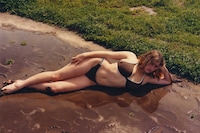Captured in Isla Vista, California, the photographer’s new book depicts a dilapidated paradise alive with the sweat, chaos, and closeness of youth
The first time photographer Cam Lindfors visited Isla Vista, a coastal enclave just north of Santa Barbara, California, it felt like stepping into a sun-drenched dream. Two young men were standing around a battered Coleman grill, blackening meat beyond recognition in the bed of a lifted pickup truck, just blocks from the Pacific. It was an absurd and completely sincere day. “I instantly fell in love,” Lindfors recalls. “This is the place – this is the bee’s knees.”
It was the first photograph Lindfors took for what would later become One Half Paradise, his newly released photo book that blends photography and film to create a vibrant portrait of Isla Vista as a fleeting college town. The book depicts Isla Vista as equal parts paradise and collapse: a place where cliffs crumble into the ocean and mould-stained houses sag under the weight of many tenants; where the mood is both euphoric and apocalyptic. “That perfect California glow, the one we’ve seen in movies and on TV, is constantly clashing with the lived-in reality of Isla Vita,” Lindfors says.
The book, shot over the course of a year, documents the place in all its contradictions. “It has all the vibes of Baywatch, American Pie, Endless Summer, even Lords of Dogtown. But the roofs are leaking. The plumbing is falling apart. There are cracks in the walls ... Climate change isn’t a metaphor here – it’s a certainty.”

What emerges is a kind of environmental portrait, but also an emotional one. Three friends, barefoot, half-dressed, and unhurried, bask in the late-afternoon sun. Two boys lock into a sunlit wrestle by the ocean against a backdrop of fading light. A girl swings from the rafters of a cluttered garage as her friend reaches up towards her. The images feel undeniably youthful: alive with sweat, chaos, and closeness.
But Lindfors insists he never set out to make a book about youth culture. It felt too easy, too clichéd. “I’ve never been particularly interested in youth,” he says. “Not as a cultural fixation, not as something to archive.” Perhaps that’s because, for the photographer, youth was never something to document, but a time during which to recover. “When I had cancer in college, I didn’t get to experience much of what I ended up photographing in Isla Vista,” he says. “That time in my life didn’t stretch outward. It folded inward.”

But One Half Paradise resists the trap of nostalgia. The intimacy it captures is unsentimental, even sharp-edged. Working quickly, sometimes photographing 30 or 40 strangers with the help of collaborator and friend Em, Lindfors developed what he calls a “slick tongue,” a way of cultivating trust with just a few words. “I had to read the room’s energy … make [people] comfortable in front of my camera,” he says. “I wasn’t after staged moments. I wanted things to feel remembered – like they had already happened on a different day, and might happen again, with or without me.”
In the end, One Half Paradise is less a photo book than a time capsule – a truthful record of a place suspended between seasons, decades, and states of being. “You have no idea which decade anyone belongs to,” Lindfors says. “That creates something euphoric, yes, but also grotesque and vivid. Almost like a T-shirt left too long in the sun.”

If the photographs carry an afterglow, it’s the traces of something that’s already fading. “Paradise is never built to last,” Lindfors says. “It just exists.” The town is slipping into the sea. The students will graduate and move on. But for a flicker of time, in this crumbling, radiant corner of California, something beautiful held, and Lindfors was there to capture it.
One Half Paradise by Cam Lindfors is self-published, and is out now.






